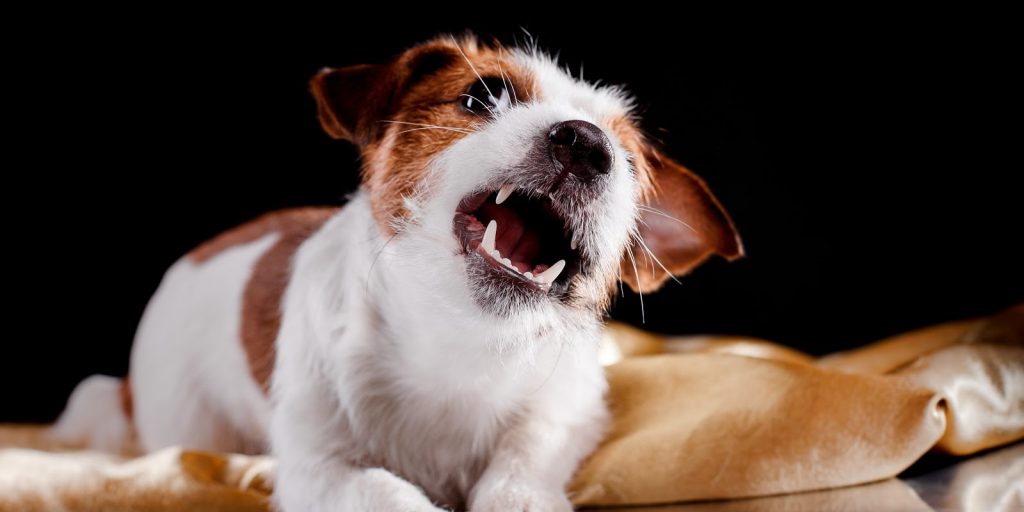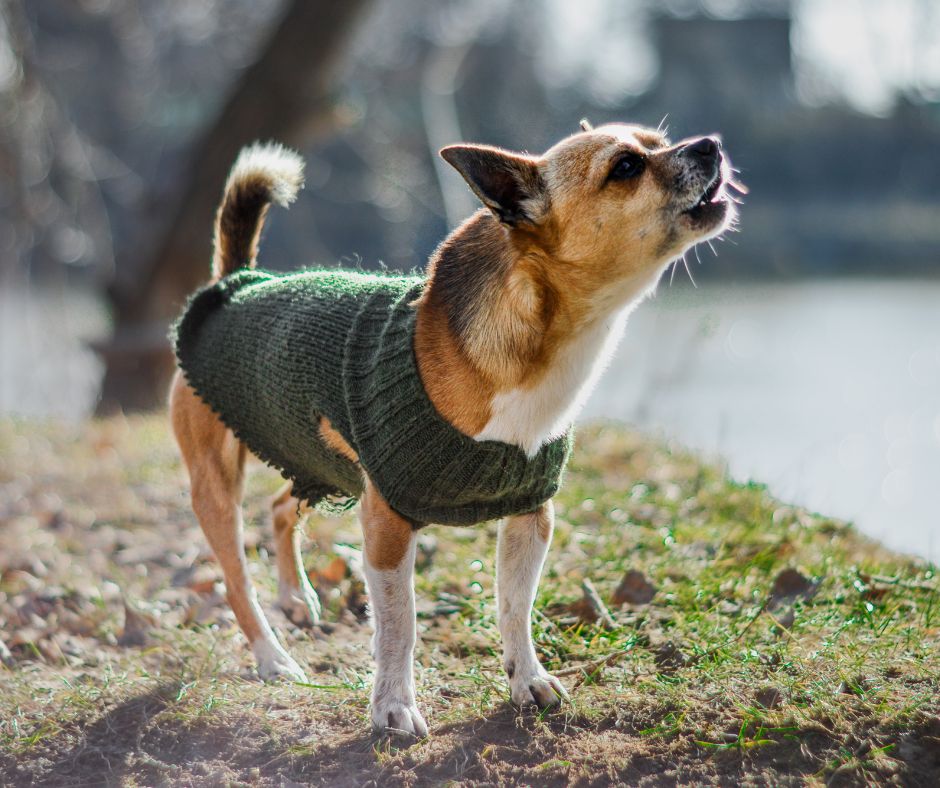For many dog owners, dealing with a reactive dog can be both challenging and stressful. This is especially true when trying to train a dog who is prone to barking, lunging, or exhibiting aggressive behaviors toward other dogs or people. However, with the right tools and techniques, it is possible to help your furry friend mellow out. Keep reading to learn more!

1. Understand your reactive dog’s triggers
By understanding what triggers your dog’s reactive behavior, you can take steps to avoid or manage those triggers, reducing the likelihood of a negative reaction. This also helps you be proactive in training and behavior modification.
Identifying your dog’s triggers isn’t always as easy as it sounds, mostly because we think it’s as easy as it sounds if that makes sense. For example, if Fido snaps and lunges at your neighbor’s chihuahua Fifi every time he sees her, it’s not a far stretch to assume that Fifi is the trigger. But what if she’s not? What if Fido is really triggered by Fifi’s owner? Or maybe he’s triggered by the idea of Fifi finding that bone he spent so much time and energy burying? Or perhaps Fifi only comes out on garbage day, and it’s really the garbage truck that’s freaking Fido out.
Basically, we look at the easiest possible explanation, assuming that Occam’s Razor applies to dogs as well as…well, whatever Occam’s Razor actually applies to. Then again, maybe he really does just hate Fifi.
My point is, finding your dog’s TRUE trigger can be a bit more challenging than you’d think. However, there are several steps you can take to make it easier:
- Observe your dog’s behavior: Start by observing your dog’s behavior in different environments and situations. Note when your dog seems anxious, fearful, or aggressive, and take note of the specific triggers that seem to be causing these reactions.
- Keep a journal: Keep a journal of your dog’s behavior, noting the time, location, and specific triggers that seem to be causing reactive behavior. Make sure you include other notes, such as what else was happening in the environment, if other people were present, and so on. This can help you track patterns and identify common triggers.
- Consider your dog’s body language: Watch for signs of stress or anxiety in your dog’s body language, such as a lowered tail, flattened ears, or raised hackles. These can be indicators that your dog is feeling uncomfortable or threatened.
- Work with a professional: Consider working with a professional dog trainer or behaviorist who can help you identify your dog’s triggers and develop a plan to manage and modify their behavior.
Ultimately, gaining a clear understanding of your dog’s triggers and accompanying body language will help you move on to the next steps of reactive dog training.

2. Start with basic obedience training to build a solid foundation
Basic dog training is an essential aspect of working with a reactive dog, as it helps establish clear communication between you and your dog and builds the foundation for addressing reactive behavior. After all, you can’t really teach your dog to ignore triggers if you can’t even get him to sit or stay.
One of the primary benefits of basic dog training is that it helps your dog learn essential commands and behaviors, such as “sit,” “stay,” and “come.” These commands provide structure and guidance for your dog, helping them understand what is expected of them and what behaviors are appropriate in different situations.
In addition, basic dog training can help build a stronger bond between you and your dog, as you work together to learn and practice new skills. This can help your dog feel more secure and confident in their environment, reducing their likelihood of reactive behavior.
However, it’s important to note that effective dog training does not rely on outdated concepts like “dominance” or “pack leadership” and instead focuses on positive reinforcement (more on that in a moment) and humane training methods.
3. Stick with positive reinforcement techniques
Positive reinforcement dog training is essential when training a reactive dog, as it provides a humane, effective approach that can help your dog feel more comfortable and secure in their environment. Reactive dogs are often fearful, anxious, or aggressive in response to certain triggers, and traditional training strategies that rely on punishment or dominance can actually exacerbate these issues and make reactive behavior worse.
It also creates a positive association between your dog and the training process itself. Rather than feeling scared or anxious during training sessions, your pooch will begin to associate training with fun, treats, and positive experiences. In other words, Fido realizes that good behavior equals good things for him. This can help reduce their overall stress levels and make them more receptive to training.
Plus, positive reinforcement training can be used to teach your dog alternative behaviors that are incompatible with reactive behavior. For example, you might train your dog to sit or focus on you when they encounter a trigger, rather than reacting with aggression or anxiety. By rewarding and reinforcing these alternative behaviors, you can help your dog feel more confident and secure in their environment and reduce their likelihood of reactive behavior.
4. Avoid punishment or aversive training methods
Please, please, please DO NOT use negative “punishment-based” training methods on your reactive dog. Punishing a dog for reacting to his triggers can lead to increased anxiety and may actually reinforce the reactive behavior.
Aversive methods like shock collars and physical corrections can cause physical and emotional harm to your canine companion and are not an effective long-term solution. In fact, studies show that such methods can actually increase reactivity and aggression.
Instead, focus on using reward-based training methods, like treats, toys, and praise as we discussed above.
5. Gradually expose them to triggers in a controlled environment
Gradually exposing a reactive dog to their triggers in a controlled environment is a key component of desensitization and counterconditioning, two methods commonly used to address reactive behavior in dogs.
This technique involves exposing dogs to the situations or objects that trigger their reactive behavior and gradually increasing their exposure, all while ensuring the environment remains safe and controlled.
Using the earlier example, if Fido becomes reactive around Fifi, a trainer may start with controlled interactions with known calm and non-reactive dogs before gradually introducing the dog to more complex scenarios.
Here are some steps you can take to gradually expose your reactive dog to their triggers in a safe and controlled manner:
- Identify your dog’s triggers: If your skipping ahead and haven’t already done this, go back up to step one to learn how.
- Create a controlled environment: Choose a quiet, controlled environment where you can slowly expose your dog to his triggers without overwhelming him. A quiet park early in the morning before it gets busy or your fenced-in backyard could work.
- Start at a distance: Begin by exposing your dog to his trigger from a safe distance, such as across the park or on the other side of a fence. This distance should be far enough that your dog is aware of the trigger but not so close that they become reactive.
- Reward positive behavior: When your dog notices their trigger but does not react, reward him.
- Gradually decrease the distance: Over time, gradually decrease the distance between your dog and his trigger, always rewarding positive behavior and taking breaks if your dog becomes overwhelmed.
- Repeat, repeat, repeat: Continue to repeat the process over time, gradually exposing your dog to their triggers in a safe and controlled manner.
Ideally, desensitization and counterconditioning should be done under the guidance of a professional dog trainer or behaviorist, if you can afford it.
6. Reward calm behavior and ignore reactive behavior
One effective reactive dog training tip to help Fido mellow out is to reward calm behavior and ignore reactive behavior. Many reactive dogs display aggressive behavior when they feel overwhelmed or threatened, and this can be exacerbated by the owner’s attention.
One way to break this cycle is to reward calm behavior with praise, affection, or treats while ignoring reactive behavior. For example, if Fido barks and lunges at another dog while you’re out for a walk, calmly move him away and wait for him to calm down.
Once he does, reward him with praise or a small treat. This will help him understand that calm behavior is desirable and that reactive behavior will not be rewarded. With consistent practice, Fido will learn to remain calm in stressful situations and become a happier, more well-behaved companion.
7. Use tools such as a front-clip harness for extra control
Using tools such as a front-clip harness along with your regular dog collar can provide extra control and help your dog remain calm during walks. They work by allowing you to redirect your dog’s attention toward you, rather than the trigger causing the reactive response.
The front-clip harness attaches to the front of the dog’s body and allows you to gently steer them, while the head collar works by gently guiding their head in the direction you want them to go. .
8. Consider hiring a professional dog trainer for additional support
If you’re struggling to manage your reactive dog’s behavior on your own, consider hiring a professional dog trainer for additional support. Reactive dog training requires an experienced and skilled trainer who understands your dog’s behavior and how to modify it.
A good trainer can develop a customized training plan that addresses your dog’s specific needs and triggers. They can also help you work on obedience training and create a structured routine for your dog.
A professional can also provide guidance and support throughout the training process, helping you set attainable goals and monitoring your dog’s progress. If you decide to go this route, just search “reactive dog training near me” to find a good starting list. Please do your homework and choose a trainer that focuses on positive methods. If they use phrases like “be the pack leader” or “show your dog who the alpha is,” move on to someone else.
9. Remember that every dog is unique
When it comes to reactive dog training, it’s essential to understand that each dog is unique and may require a personalized approach. What works for one dog may not work for another. Some dogs may have a stronger prey drive, while others may be reactive due to fear, anxiety or past trauma.
In other words, you need to tailor your dog’s training to YOUR dog. If something isn’t working, try something else. As long as you make sure you’re sticking with positive methods, it’s okay to switch strategies. I mean, I wouldn’t bounce from method to method without giving any of them a chance to actually work. But if you’ve been working with Fido for 6 months using clicker training, for example, and it’s just not making a single bit of difference, then it’s definitely okay to try something else.
10. Consistency and patience are key
I know this kind of goes against what I literally just said two sentences ago, but when it comes to any form of dog training, consistency and patience are crucial for success. That’s especially true when dealing with a reactive dog. These dogs can be notoriously challenging to train, as they tend to exhibit extreme behaviors such as barking, lunging, and even biting.
However, with a consistent approach, patience, and appropriate training techniques, positive changes can be seen over time. It is essential to understand that training a reactive dog is a long-term process that requires time, commitment, and dedication.
Again, though, if you’ve been consistent and patient for a year and nothing has changed, then it’s 100% rational to consider a new method.
Conclusion
While having a reactive dog can be a challenging and stressful experience, it doesn’t mean you can’t help Fido learn to mellow out. By taking baby steps, using positive reinforcement, seeking the help of a professional trainer, and staying patient and consistent, you can help your furry friend become a more confident, relaxed, and well-behaved companion. Remember, with love, patience, and effort, you can successfully train your reactive dog and create a happier, calmer, and more peaceful home environment for both you and your furry friend.

